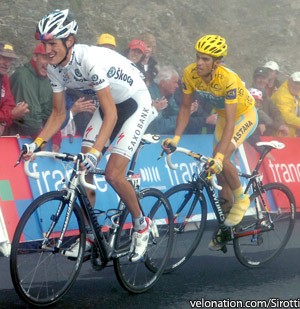How come this year’s final mountain stage delivered such drama, when last year’s version couldn’t?
 Today’s stage between Pau and the Col du Tourmalet gave us the kind of dramatic mano a mano battle rarely seen in the Tour de France since the days of Jacques Anquetil and Raymond Poulidor. Images of white jersey Andy Schleck (Saxo Bank) doing battle with yellow jersey Alberto Contador (Astana) on the slopes of the mythical climb can take pride of place alongside those of the two French legends of the 1960’s.
Today’s stage between Pau and the Col du Tourmalet gave us the kind of dramatic mano a mano battle rarely seen in the Tour de France since the days of Jacques Anquetil and Raymond Poulidor. Images of white jersey Andy Schleck (Saxo Bank) doing battle with yellow jersey Alberto Contador (Astana) on the slopes of the mythical climb can take pride of place alongside those of the two French legends of the 1960’s.
So what happened last year, when we were supposed to be treated to the strongest riders of the race tearing chunks out of each other on the penultimate stage to Mont Ventoux?
The main difference between this year and last is that by the time the race hit the slopes of the Ventoux in 2009, the race for yellow was all but over. Contador led Schleck by an almost insurmountable 4’11”, whereas this time the gap was – and still is – a scant, Lemond-esque, 8 seconds.
If Schleck could have cracked Contador today he could have moved into yellow, started last in Saturday’s time trial, and given himself every chance of winning his first Tour de France. Last year, with first and second decided the fight on Ventoux was for the third step, with Schleck trying to get elder brother Fränk the 40 seconds be needed to overtake seven-time winner Lance Armstrong; Contador was trying to stop him and keep the American on the podium.
The result was the two strongest riders in the race working as domestiques for their teammates.
The big difference between this year’s course and last though, is the amount of time trialling and the position of those time trials in the race. By the time the race arrived at the foot of the Ventoux in 2009, Contador had taken 42 seconds out of Schleck on stage 1 in Monaco, 40 seconds in the team time trial in Montpelier, and 1’45” in stage 18 in Annecy. The planners clearly expected the race up to that point to be an evenly matched battle between the climbers and time triallists; little did they know – as he’d not been there the year before – that the best climber and the best time triallist were one and the same man.
This year the Tour’s route planners knew exactly who would be the best riders in the race and designed a course to suit. Aside from the 42 seconds that Contador took from Schleck in the rain-ruined Rotterdam prologue, the two have been exchanging seconds here and there. Had “Chaingate” happened last year it would have been dismissed as unimportant; this year, those 39 seconds could be the difference between winning and losing in Paris on Sunday.
Obviously, the course planners couldn’t have known that the top two riders in the race would start the final Pyrénéen stage separated by just 8 seconds. With Contador denied the opportunity to use his time trialling strength to put serious time into his rivals though, it was always going to be close.
With Contador and Schleck still so closely matched the drama continues to Saturday’s stage, the only long time trial of the race. While credit is due to the two riders for keeping the fight going for so long; kudos to the course designers for giving them a route to do it on.